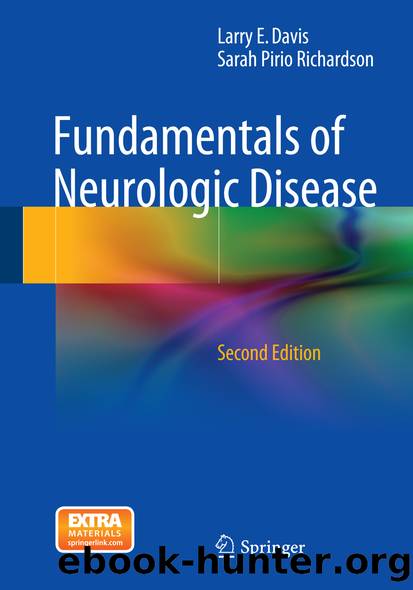Fundamentals of Neurologic Disease by Larry E. Davis & Sarah Pirio Richardson

Author:Larry E. Davis & Sarah Pirio Richardson
Language: eng
Format: epub
Publisher: Springer New York, New York, NY
Major Clinical Features
The diagnosis of Parkinson’s disease is usually made by the presence of asymmetrical bradykinesia in the limbs, cogwheel rigidity (of the wrist or elbow), resting limb tremor, and a good response to levodopa. Approximately 70 % of patients will have tremor at some point in their disease course. Only half of those patients will have a tremor that is responsive to levodopa. Rigidity is a constant resistance to passive muscle stretching in both flexors and extensors throughout range of motion due to the stretching force inducing some antagonistic motor units to fire. In Parkinson disease, the rigidity is constant regardless of the speed of the passive muscle stretch. Spasticity is different and is dependent on the speed of the movement. In addition, flexion and extension or rotation of wrist or elbow often elicits a ratchet-like feeling (cogwheel rigidity).
The disabling feature of PD is bradykinesia. One patient described early bradykinesia as walking in a swimming pool with water up to his neck and advanced bradykinesia as walking in a swimming pool filled with molasses. Thus, patients spend enormous amounts of energy and time performing routine activities of daily living.
Everything “slows down” in the patient with PD. Limb and chewing movements are slow; gait is slow, shuffling, difficult to initiate, and often with a stooped posture; standing balance is impaired from slow corrective steps to maintain balance so falling is common; spontaneous facial expression is minimal (masked facies); gut peristalsis is slow and constipation is common, and mental activities are slower than normal so there is less spontaneous speech and delayed answers (bradyphrenia) to questions spoken in a soft, dysarthric voice. In many patients, cognitive problems such as executive dysfunction and memory loss will develop. About 40 % of patients also develop dementia that may be due to dementia with Lewy bodies or the coexistence of two common diseases of elderly, Alzheimer disease and PD.
Download
This site does not store any files on its server. We only index and link to content provided by other sites. Please contact the content providers to delete copyright contents if any and email us, we'll remove relevant links or contents immediately.
When Breath Becomes Air by Paul Kalanithi(7268)
Why We Sleep: Unlocking the Power of Sleep and Dreams by Matthew Walker(5649)
Paper Towns by Green John(4173)
The Immortal Life of Henrietta Lacks by Rebecca Skloot(3829)
The Sports Rules Book by Human Kinetics(3592)
Dynamic Alignment Through Imagery by Eric Franklin(3493)
ACSM's Complete Guide to Fitness & Health by ACSM(3470)
Kaplan MCAT Organic Chemistry Review: Created for MCAT 2015 (Kaplan Test Prep) by Kaplan(3428)
Introduction to Kinesiology by Shirl J. Hoffman(3305)
Livewired by David Eagleman(3128)
The River of Consciousness by Oliver Sacks(2995)
Alchemy and Alchemists by C. J. S. Thompson(2915)
The Death of the Heart by Elizabeth Bowen(2908)
Descartes' Error by Antonio Damasio(2740)
Bad Pharma by Ben Goldacre(2731)
The Gene: An Intimate History by Siddhartha Mukherjee(2495)
Kaplan MCAT Behavioral Sciences Review: Created for MCAT 2015 (Kaplan Test Prep) by Kaplan(2493)
The Fate of Rome: Climate, Disease, and the End of an Empire (The Princeton History of the Ancient World) by Kyle Harper(2441)
The Emperor of All Maladies: A Biography of Cancer by Siddhartha Mukherjee(2433)
